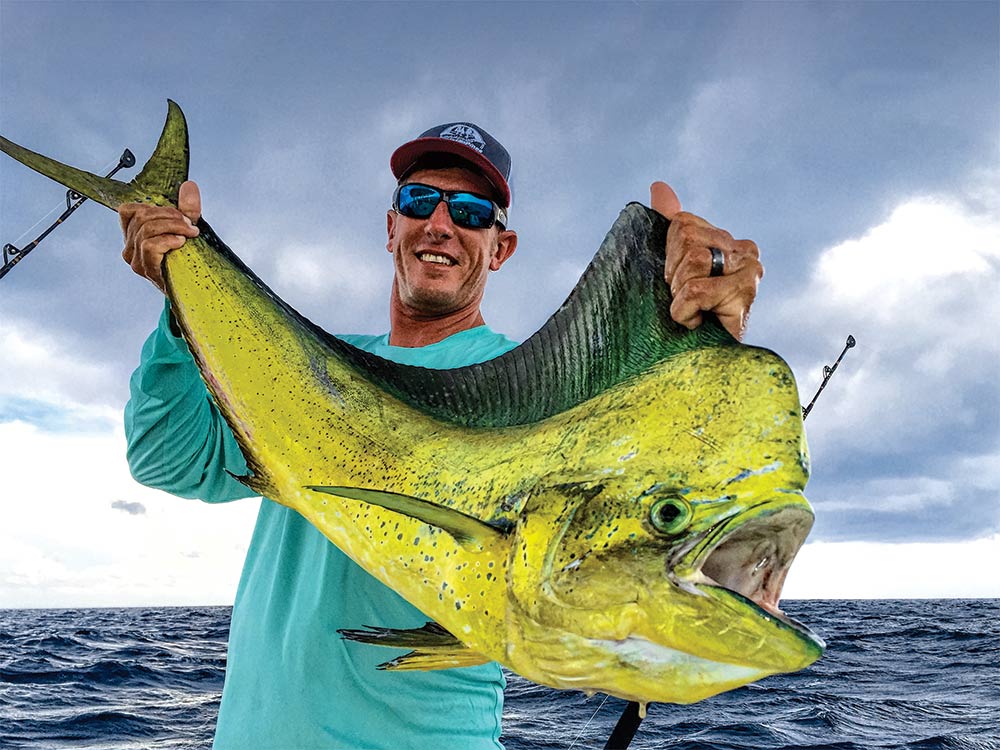
A line of sargassum stretched for about a half-mile, in 1,100 feet of royal-blue water off Islamorada in the Florida Keys. Capt. Shannon Attales and I had been running and gunning most of the morning, until this find.
After looking for dolphin by cruising up and down the line to no avail, the quantities of baitfish huddling underneath the weeds convinced us to back off the throttles and go on the troll. It was the right move.
With two ballyhoo skipping behind outriggers and two off flat lines, we settled into an up-sea trolling pattern along one side of the weed line, steering around displaced clumps. We hadn’t finished our first pass before the 30-pound monofilament line racing off the starboard transom outfit startled us, followed by a big bull dolphin leaping from the sea. Then another big bull hit an outrigger bait, and then a third charged through the spread. Attales and I were hooked up with two large bulls and trying for that third fish, all while the boat was moving along, exactly the chaos that dolphin anglers love.
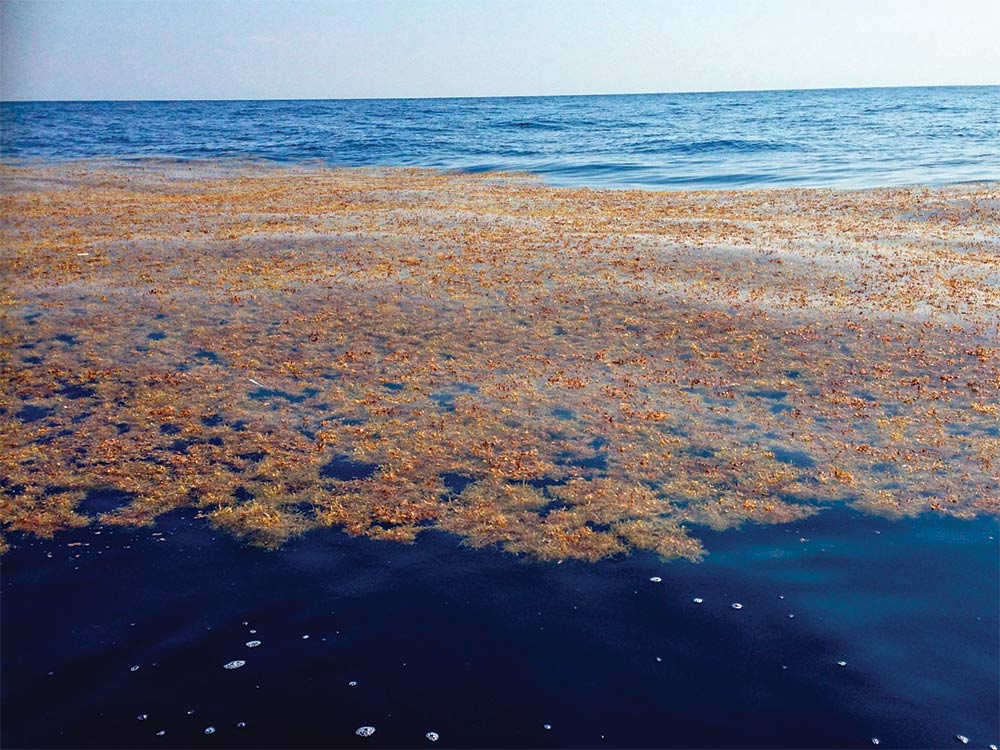
Follow and Understand the Current
This was in August, on the backside of the dolphin season in the Florida Keys. However, as Attales acknowledges, August and September offer good odds for scoring large dolphin in less-crowded waters. Prior to these two slammers, our earlier running-and-gunning efforts boxed five 8- to 12-pound dolphin, uncovered a school of small ones, and saw Attales jump off a 25- to 30-pounder.
“These fish can be 30 miles out one day, and then in 300 feet of water the next,” Attales says. “Keep a close eye on what the current is doing. When you see that bluish-green water change to purple, that’s prime dolphin water. Let’s say I run offshore and find that color water, weeds and fish in 800 feet. If this edge and weeds are moving shoreward, which is common here, the next day I’ll start looking for fish in 500 to 600 feet.”
Locating the western edge of the Gulf Stream and any fingering (warm water spinning off the main flow) is an excellent starting point. Areas where the edge of the Stream or any fingers intersect bottom structure or the continental shelf attract dolphin. Credit this to upwellings and bait concentrations resulting from this collision. Water-surface-temperature charts reveal these productive zones. Further, study the movements of weeds and color breaks to predict where they’re likely to be the next day.
Tips for Dolphin Fishing in Florida
Working birds, particularly frigates, are excellent, reliable signs. With practice, open-array radars can be fine-tuned to mark birds. And some radars, such as my Simrad with Bird Mode, automatically tune themselves. Knowing how to read the birds on the screen — and recognize visual clues — saves effort and fuel. For example, large clusters of birds, especially in late summer, often signify skipjacks in cooler water. Other than an odd dolphin or two on the outskirts, it’s best to keep searching. Fewer birds working with the current are often on school fish. And even fewer birds working into the current often indicate larger dolphin. Naturally, there are exceptions.
Weed lines create cover for a variety of juvenile sea life, and where smaller sea life abounds — brine shrimp, sargassum fish, puffers, bar jacks, banded rudder fish — count on larger predators, particularly dolphin, seeking them out. If a weed line is devoid of life, run parallel to it, periodically stopping to check for life, or continue searching. It’s all about finding forage.
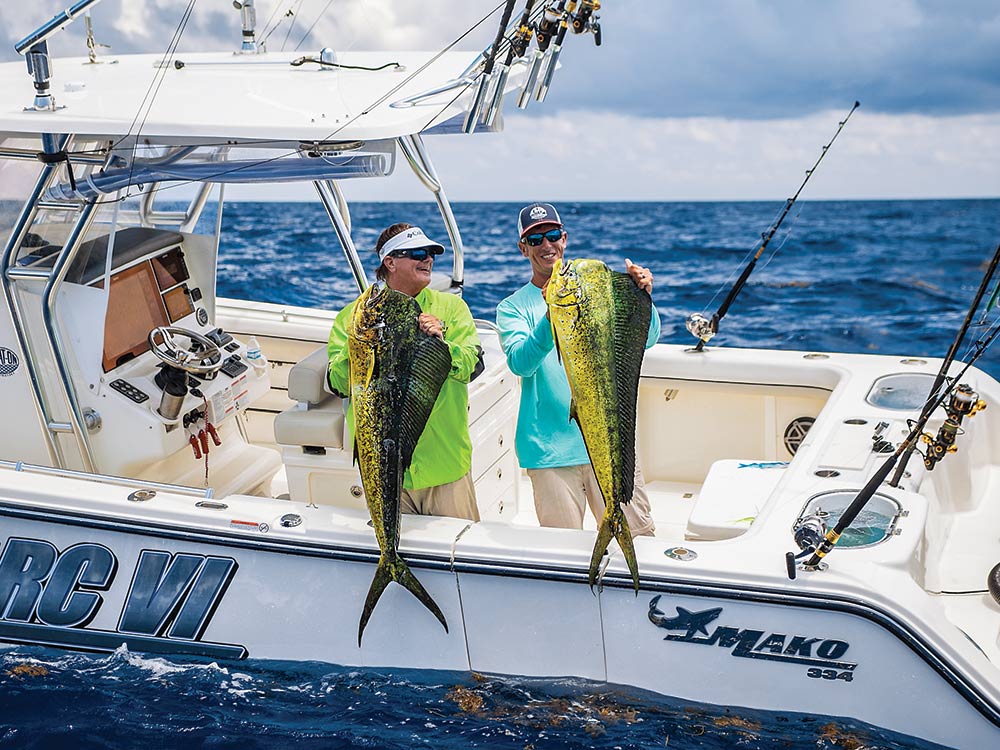
Run-and-Gun Strategy
Early starts are important, yet bolting from the stable too early could cost you fish.
“It’s easy to pass up weed lines you don’t even see,” Attales says. “Sargassum weed has bulbous gas capsules. Photosynthesis creates gas in these capsules that floats the weeds. At night, these gases dissipate, and the weeds settle beneath the surface. How many times have you run well offshore early in the morning and not seen a weed line, yet you’ll see two or three solid lines on your afternoon run back in?”
To avoid overrunning weeds, Attales watches the sonar, stopping for a closer look around surface slicks and bits of weed that can tip off a weed mass below.
He runs and guns in the morning, until he has solid knowledge about what’s out there and where he needs to concentrate. Naturally, he’ll parallel any weed lines or edges, looking for birds, debris and fish. And bottom contour lines are crucial.
“Edges that contain weeds and such often occur along bottom contour lines washed by current,” he says. “We’re not running blindly out here; we’re paralleling contours. Even when there are no weeds or debris, these bottom contours produce upwellings and hard rips that hold fish.”
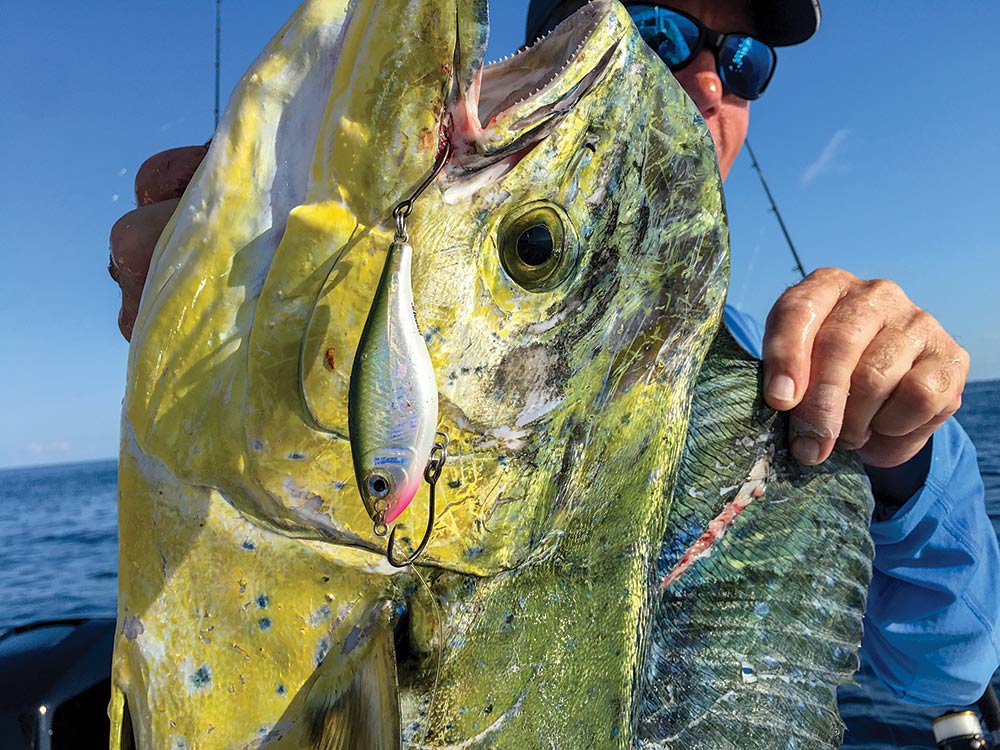
Trolling for Dolphin
As our outing proved, trolling produces fish, but you have to have the right dolphin fishing rigs ready. Large, well-defined weed lines are often better trolled. Dolphin may be holding deep under a weed line and possibly overlooked when running and gunning and traveling fast. On the troll, odds of finding fish — both large ones and schoolies — increase dramatically. There’s also the chance of hooking a billfish, wahoo or tuna.
Spot trolling is a fast way to test an area. If you’re unsure whether to run and gun or troll along a solid line or fishy-looking zone, simply dispatch two lures off the flat lines. If it’s dead, crank up the lures and keep on trucking; waste no time on dispatching and retrieving an elaborate trolling spread. However, if signs look promising, set out the full spread and give the area a legitimate working over. Remember, patience is a virtue when trolling.
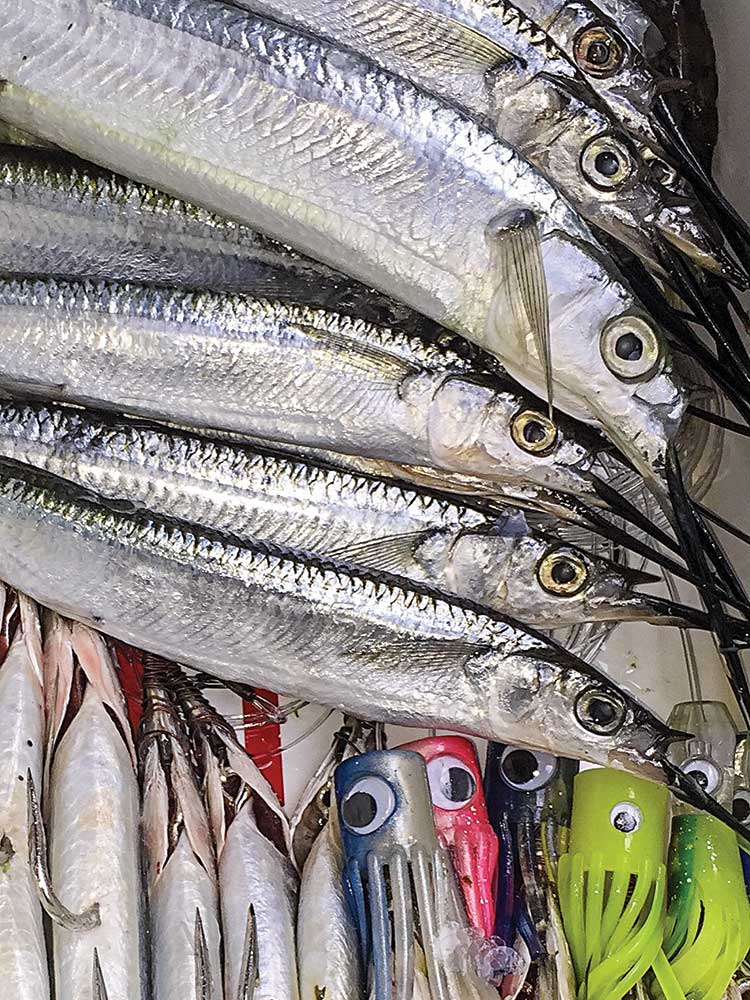
In a weedless ocean, don’t panic. Concentrate on bottom contour lines, rips and even the edge along the continental shelf in 600 feet. Pockets of flying fish activity are also good trolling areas. The rips that occur off the Florida Keys are solid trolling zones, the more turbulent, the better.
“I’ve seen dolphin surfing down these rips and chasing flying fish,” Attales says. “Get ahead of them with a pitch bait or trolling spread.”
If you troll, stay in the same area where you saw or caught a fish when running and gunning, he says. “The fish might be confined to a square-mile area. Don’t stray too far from where you’ve seen fish. Try running a bit up-current and regrouping.”
When a dolphin is hooked up on the troll, there could be several others with it. Maintain trolling speed and direction to encourage multiple hookups. When fighting a fish, always keep a bait soaking beyond the activity. Many times, a big bull or cow stalking the perimeter will move in. It’s a most pleasant surprise.
And lastly, keep a pitch-bait spin outfit ready to go with a fresh ballyhoo, squid or live bait. It will become the most important outfit on the boat when a big dolphin appears under a bird, around debris, or simply swims past the boat. And these loners are usually big — exactly the ones we don’t want swimming away.
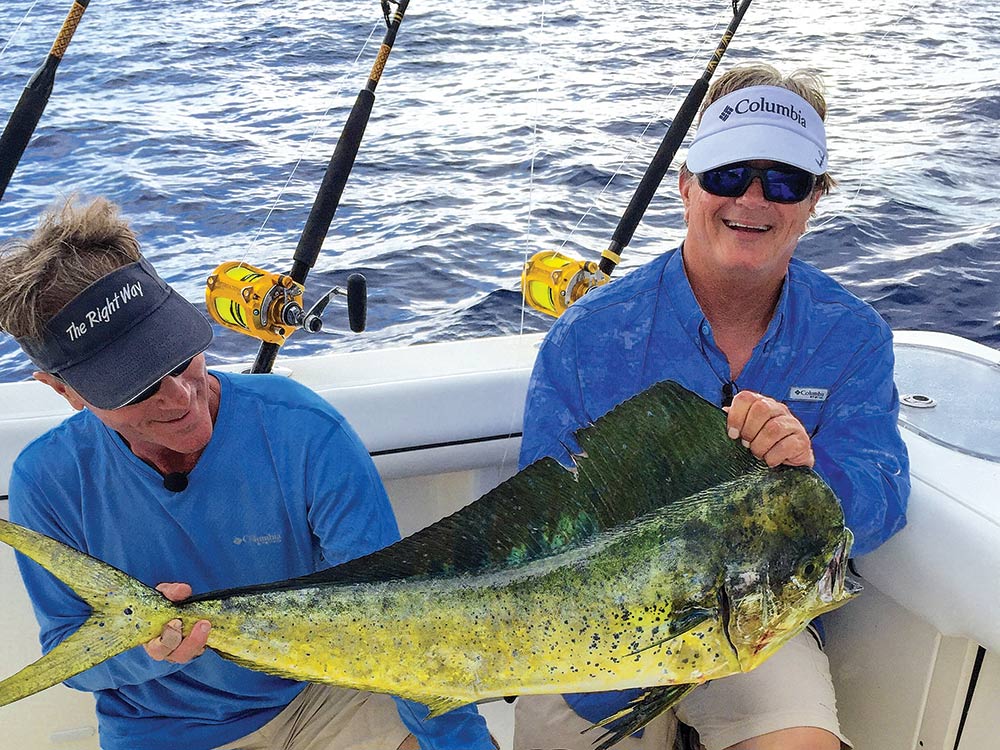
SWS Trip Planner
What: Dolphin
Where: South Florida, Florida Keys
When: April through September
Who: Dolphin offer the perfect DIY opportunity, provided you have enough boat for offshore runs. These pros also can put you in the action, or check out one of the charter operations below.
Capt. Shannon Attales
Warbird
305-522-5587
Warbird Fishing Charters website
Capt. Brian Cone
Contagious
305-481-7689
Contagious charters website
Capt. Paul Ross
Relentless
305-853-5436
Relentless charters website
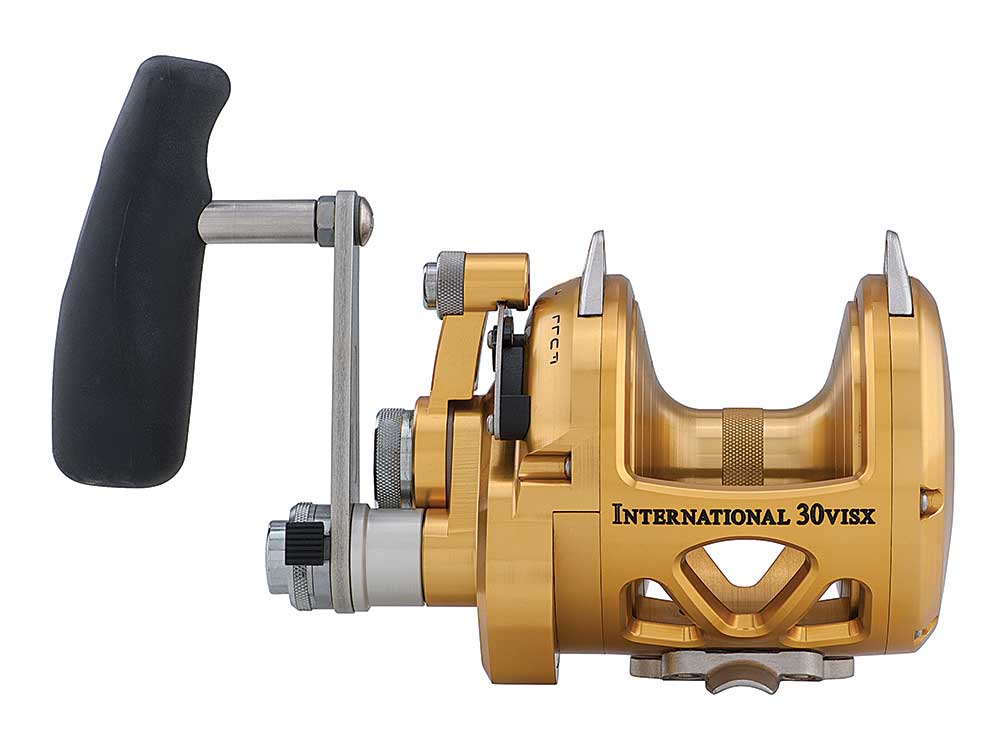
Tackle Box
Trolling for Dolphin
Reels: Penn International 30, or similar-size conventional reels
Rods: 51⁄2- or 6-foot stand-up, rated for 50- to 80-pound line
Line: 30-pound mono
Leader: 8 to 10 feet of 80- or 100-pound mono or fluorocarbon
Hooks: Based on size of bait, but usually 7/0 to 8/0, Extra Strong O’Shaughnessy-style
Baits: Fresh ballyhoo, strip baits; small- to medium-size trolling lures
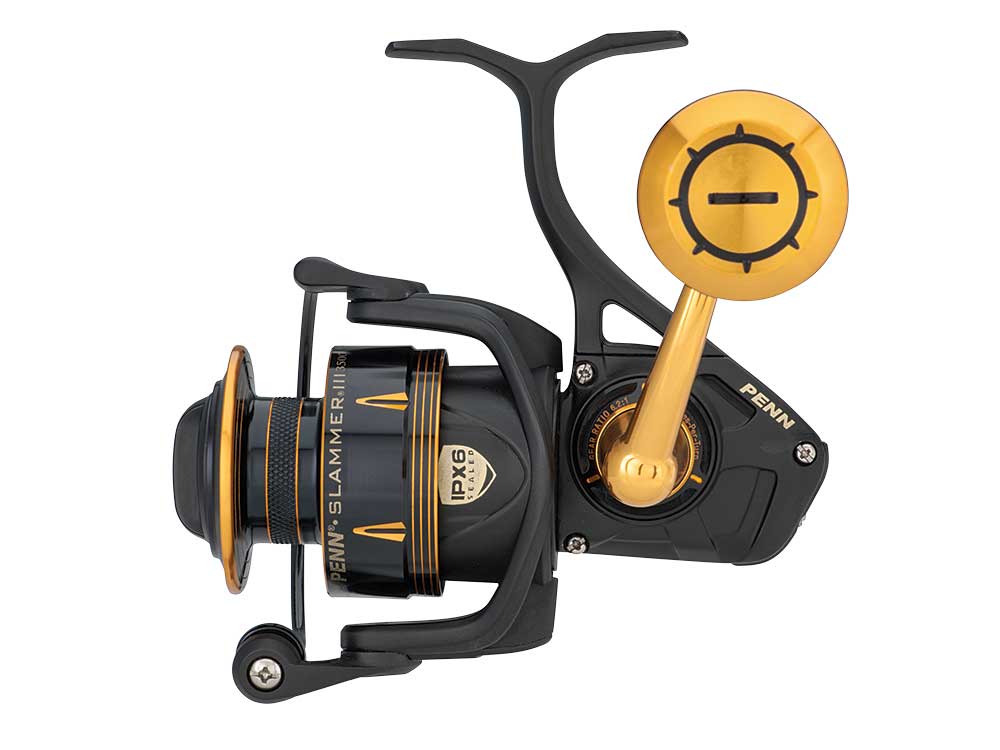
Run and Gun for Dolphin
Reels: Penn Slammer III 5500 to 7500, or similar-size spinning
Rods: 7-foot, rated for 30- to 50-pound line
Line: 12- and 20-pound mono
Leader: 40- or 50-pound fluorocarbon, 15 feet long (wind-on)
Hooks: Single 6/0 to 8/0, J-style
Baits: Squid, fresh ballyhoo, live bait, topwater chugger
Fast Facts for Success
Edges: Scout for temperature breaks, especially over structure.
Live Targets: Concentrate on birds and surface weeds.
Intel: Study daily current changes for trends to consistently find fish.
Top Tricks for Dolphin
Trick No. 1: Topwater chuggers raise dolphin. Curious by nature, dolphin rise from the depths, drawn by the commotion. Even school fish that have retreated after being worked over will come back for another look. Choose a topwater chugger, such as the Williamson Popper Pro 130 with two single hooks, to mimic a flying fish.
Trick No. 2: When stopping to investigate a find, send a live bait down a hundred feet or so. When dolphin hold deep, this bait can make your day. Position a 10-ounce breakaway sinker 40 feet above the leader and lower the bait to the desired depth. Opt for a 40- or 50-pound fluoro leader, but be advised: Wahoo also lurk deep. A wire leader reduces bites but could save a wahoo. It’s your call.









